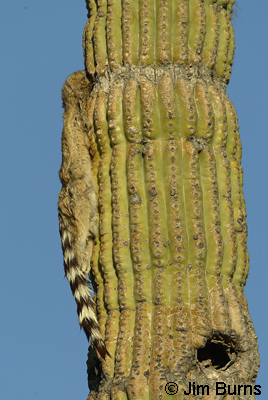
At first glance this appears to be a ringtail climbing a saguaro. Ringtails are mammals related to raccoons and coatis, and they inhabit rocky areas throughout the desert southwest. Much more common than realized because they are strictly nocturnal, it's very rare to see one in daylight. So, what's wrong with this picture? Well our visits to the scene were a week apart and the ringtail hadn't moved. This is a ringtail carcass suspended from the saguaro's spines.
Here are two additional clues. On Laurie's trip there was a pile of mourning dove feathers below the saguaro which had vanished by my visit. And 30 yards away in another saguaro there is a huge stick nest. As with any good riddle, these facts may help or they may lead you astray. Be formulating your solution while I walk you through what Laurie and I think happened.
Ringtails eat birds and bird eggs, and mourning doves do build nests in saguaros. Dove nests, though, are small, flimsy platforms of twigs, and there were no dove nests in the ringtail saguaro. Saguaros are known as desert apartment houses. Lucy's warblers, woodpeckers, flycatchers, and starlings nest in saguaro cavities, so It's possible the ringtail was climbing up to raid a nest cavity, such as the one to the right of its tail, and impaled itself on the spines. But we don't think ringtails can or would climb a saguaro.
The stick nest in the neighboring saguaro, with no sign of activity around it, could only have been built by Harris's hawks or red-tailed hawks, but their old nests are often appropriated by great horned owls. We both looked for owl pellets below both saguaros and for the whitewash of raptor droppings, but found neither.
Since ringtails are active only at night, it's highly unlikely daytime raptors would ever encounter one, but great horneds are the ultimate nighttime predator--fearless and opportunistic. Ringtails weigh 2 1/2 pounds which is toward the top end of the "tiger of the night's" prey range. We're thinking an owl dispatched the ringtail on the ground, carried it to the top of the saguaro to eat, but dropped it and it snagged on the spines where the owl couldn't retrieve it. We think the large nest might be a day roost for a pair of owls or at least an old nest which marks their territory, and the ringtail saguaro may be a frequently used feeding post which would account for the dove feathers.
If there's a mammal biologist reading this, please email and tell us if ringtails climb saguaros. If there's a birder with a better solution reading this, email and let us hear it. And keep your eyes open for the hidden clues which can take you behind the scenes of our fascinating natural world.